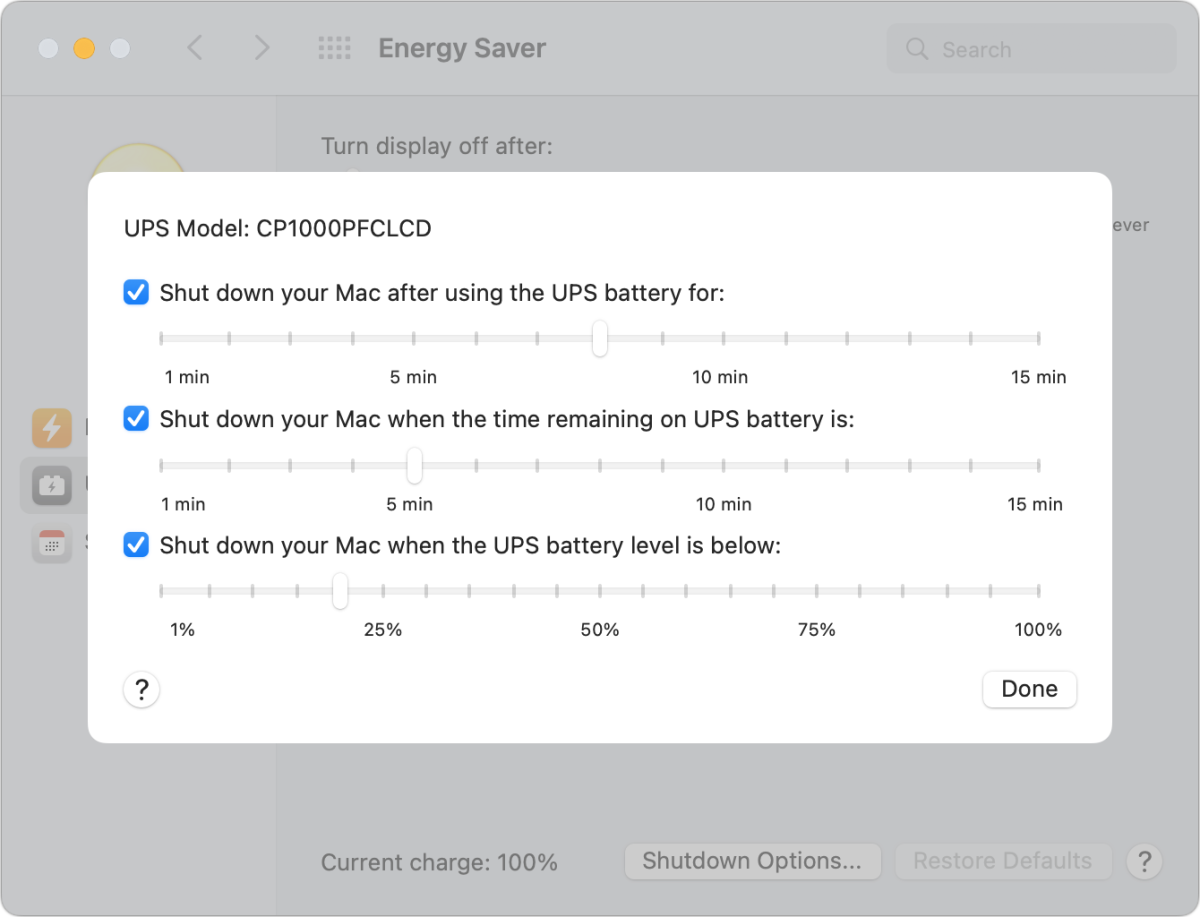An uninterruptible power supply (UPS for short) can provide continuous backup power to your devices in the event of a power outage. They can also shore up power sages (brownouts) and condition power in areas with poorly managed electrical grids. UPSes have been around for decades, and Apple began providing silent, built-in support in macOS many years ago. It’s currently found in System Preferences > Energy Saver on Macs that require being plugged in, like an iMac or Mac mini. (This will move to System Settings > Energy Saver in macOS 13 Ventura.)
At some level, a UPS is only as good as its integration with the equipment it’s helping keep going. A modern, high-capacity UPS might provide all the power necessary to keep your Mac and peripherals running during short outages that could range from a few minutes to tens of minutes. But for outages of unknown durations, you want to define parameters for an orderly shut down. While system corruption was a regular occurrence when hard drives prevailed and before changes to macOS that improved recovery, they’re still not unheard of from sudden power loss.
Every UPS model I’ve tested for TechHive has a USB jack or compatible port. All also offer downloadable software for macOS and Windows. However, the software is often outdated, hard to use, or overly detailed. In most cases, you don’t need to make low-level settings changes; if you do, it’s sometimes easier to use the front-panel settings on the UPS.
Just plugging in any of these devices via USB to your Mac allows macOS to recognize their status: it can tell when the UPS has kicked into a mode in which it’s delivering power and read its percentage of remaining power. Support is surprisingly widespread. Once plugged in, a UPS button appears in the Energy Saver pane. Click it to get access to a couple settings and a nested dialog with more.
You can set directly from the tab view how long to keep the display active after the UPS switches to backup power. Modern displays are low wattage, but you might favor turning the display off early to keep your system running longer. If you find your UPS kicking in regularly, you can enable the “Show UPS status in menu bar” option to see a special power icon. Click it to see the UPS battery’s current charge and other details identical to viewing the state of the battery on an Apple laptop.
Click Shutdown Options, and you can selectively turn on and set three parameters that control when shutdown occurs:
- After using the UPS battery for: Set a duration for how long you want your Mac to work off battery power.
- When the time remaining on UPS battery is: This is an estimate macOS generates by watching the level drop while the UPS provides power. If you have a sense of how long it takes our Mac to shut down, you can use that as a guide.
- When the UPS battery level is below: Expressed as a percentage, you can use this alongside or instead of the time remaining estimate.
 https://b2c-contenthub.com/wp-content/uploads/2022/08/mac911-ups-settings-bordered.png?resize=300%2C229&quality=50&strip=all 300w, https://b2c-contenthub.com/wp-content/uploads/2022/08/mac911-ups-settings-bordered.png?resize=768%2C587&quality=50&strip=all 768w, https://b2c-contenthub.com/wp-content/uploads/2022/08/mac911-ups-settings-bordered.png?resize=1200%2C917&quality=50&strip=all 1200w" width="1200" height="917" sizes="(max-width: 1200px) 100vw, 1200px" />
https://b2c-contenthub.com/wp-content/uploads/2022/08/mac911-ups-settings-bordered.png?resize=300%2C229&quality=50&strip=all 300w, https://b2c-contenthub.com/wp-content/uploads/2022/08/mac911-ups-settings-bordered.png?resize=768%2C587&quality=50&strip=all 768w, https://b2c-contenthub.com/wp-content/uploads/2022/08/mac911-ups-settings-bordered.png?resize=1200%2C917&quality=50&strip=all 1200w" width="1200" height="917" sizes="(max-width: 1200px) 100vw, 1200px" />Calculate the total power drive of your Mac and all other plugged-in devices, and use tools from the UPS maker to determine how much time you can function on backup power. macOS running off an SSD typically shuts down quickly–my M1 Mac mini powers down in under 20 seconds in most cases–you can time a shutdown of your own device if you’re concerned it might take more than a minute.
You can tune the shutdown settings with that data to give yourself (or software working away on tasks) the longest time available before you’re forced to go offline.
Ask Mac 911
We’ve compiled a list of the questions we get asked most frequently, along with answers and links to columns: read our super FAQ to see if your question is covered. If not, we’re always looking for new problems to solve! Email yours to mac911@macworld.com, including screen captures as appropriate and whether you want your full name used. Not every question will be answered, we don’t reply to email, and we cannot provide direct troubleshooting advice.





